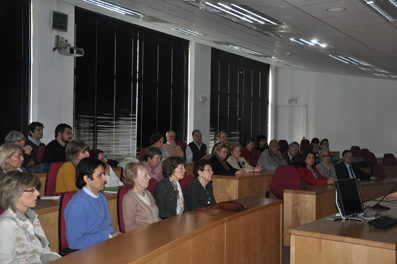March 22, 2010
Vanities and Disappointments in Spanish Golden Age Painting
D. Enrique Valdivieso. University of Seville
Throughout his exhibition, Professor Valdivieso tried to evoke a part of Hispanic Baroque thought in which, with literary supports coming from the classical Greco-Roman world and later from the Christian era, a copious amount of texts were written about the confrontation between life and death. From these texts flowed a mentality that emphasized the emptiness of earthly things and the brevity of existence, which is nothing more than a fleeting lord. At the same time this literature insisted on pointing out the need for man to prepare his soul before the arrival of death in order to attain at the moment of the judgment of the soul the superiority of his virtues over his sins, thus achieving eternal salvation and thus evading the abominable circumstance of damnation. To avoid that after the trance of death the soul would be taken to Hell, Baroque literature and painting suggested that the Christian had to lead an existence presided over by prayer, penance and chastity, avoiding incurring in the capital sins and always seeking refuge in Christ against all temptations.
This literature subject clearly influenced many pictorial works of the Hispanic Baroque, a period in which the Church spread a defined ideology that tried at all costs to persuade the faithful of the futility of all that is human, of its transitory condition and, on the contrary, of the greatness and eternity of all that is divine. For this reason, numerous paintings appeared in the Spanish Baroque period, whose iconography warns that death already stalks the human being from his childhood, threatening him at any moment of his life. Vigorous and severe images indicated that no one escapes from the Grim Reaper and on the other hand no material and earthly good can accompany us to the afterlife. In fact, through painting, an important ideological repertoire was recreated, indicating the need to despise money, wisdom, military glory and political and religious power, also formulating the idea that in the face of death the humble and the powerful are identical. These paintings also pointed out that beauty and beauty are ephemeral and perishable, also indicating that death is always hidden behind love.
The abundant projections that illustrated this talk showed the horrendous and moving images that were made in the Spanish Baroque, in which the decay and decomposition after the death of the human body triumphs, in terms not surpassed in other foreign artistic schools.
In short, in this lecture the evocation of a remnant of Baroque thought through the use of the word and the image, thus capturing admirable and accurate reflections of the thinking of an era. This mentality whose content possessed an overwhelming force crossed the frontiers of that historical moment and in many aspects has remained in force up to dates not far from the present.

The seminar of Professor Enrique Valdivieso took place at the Main Library Building of the University of Navarra.
